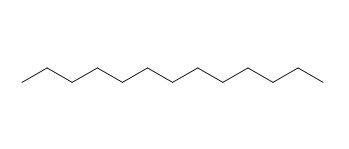n-Tridecane
Reference standards.
Inquire / Order:
manager@chemfaces.com
Technical Inquiries:
service@chemfaces.com
Tel:
+86-27-84237783
Fax:
+86-27-84254680
Address:
1 Building, No. 83, CheCheng Rd., Wuhan Economic and Technological Development Zone, Wuhan, Hubei 430056, PRC
Providing storage is as stated on the product vial and the vial is kept tightly sealed, the product can be stored for up to
24 months(2-8C).
Wherever possible, you should prepare and use solutions on the same day. However, if you need to make up stock solutions in advance, we recommend that you store the solution as aliquots in tightly sealed vials at -20C. Generally, these will be useable for up to two weeks. Before use, and prior to opening the vial we recommend that you allow your product to equilibrate to room temperature for at least 1 hour.
Need more advice on solubility, usage and handling? Please email to: service@chemfaces.com
The packaging of the product may have turned upside down during transportation, resulting in the natural compounds adhering to the neck or cap of the vial. take the vial out of its packaging and gently shake to let the compounds fall to the bottom of the vial. for liquid products, centrifuge at 200-500 RPM to gather the liquid at the bottom of the vial. try to avoid loss or contamination during handling.
Nutrients.2020, 12(5):1242.
J Breast Cancer.2015, 18(2):112-118
Molecules2022, 27(3),1140.
Appl Microbiol Biotechnol.2016, 100(9):3965-77
Chem Biol Interact.2024, 394:110995.
J Cachexia Sarcopenia Muscle.2022, 13(6):3149-3162.
J Ethnopharmacol.2024, 320:117426.
Molecules. 2013, 18(7):7376-88
Journal of Functional Foods2022, 91:105019.
The Journal of Korean Medicine2023, 44(4):26-40.
Related and Featured Products
Ind. Eng. Chem. Res. 2010, 49, 19, 8908–8919.
TiO2-Coated Cenospheres as Catalysts for Photocatalytic Degradation of Methylene Blue, p-Nitroaniline, n-Decane, and n-Tridecane under Solar Irradiation.[Reference:
WebLink]
Biostimulation based on usage of soil amendments is growing due to their efficiency in removing different petroleum hydrocarbons (PHC) from contaminated sand or loam-sand soils.
However, the research on clay-rich soils with higher organic carbon content, in which PHC biodegradation may proceed differently and which are more difficult to clean up, has been less extensive.
METHODS AND RESULTS:
In a pot experiment, we studied and compared the effects of two soil amendments, natural zeolite-containing material (ZCM, 50 g kg−1) as a bulking agent and ammonium nitrate (0.3 g N kg−1) as a nitrogen fertilizer, on biodegradation of n-Tridecane (1 wt.%) in a weakly acidic heavy clay loam leached chernozem with fairly high organic carbon content (3.71%). After 48 days, the nitrogen-amended contaminated soil showed enhancement of both respiratory activity (basal and substrate-induced respiration rates) and the number of n-Tridecane- degraders. As a consequence, the extent of n-Tridecane biodegradation (86.5%) was essentially higher in the presence of added nitrogen than that in the non-amended soil (73.7%). In contrast, due to the partial retention of n-Tridecane molecules in its pores, ZCM retarded biodegradation to 56.0%, showed no significant effect on the number of n-Tridecane-degraders and, moreover, enhanced the decomposition of the soil intrinsic organic matter.
CONCLUSIONS:
The obtained data indicate that more precautions should be considered when using porous sorbents such as ZCM for remedial arrangements in PHC-contaminated soils.
Science, 01 Nov 1960, 132(3438):1480-1481.
n-Tridecane and trans-2-Heptenal in Scent Gland of the Rice Stink Bug Oebalus pugnax (F.).[Reference:
WebLink]
METHODS AND RESULTS:
The scent-gland secretion of the rice stink bug Oebalus pugnax (F.) is composed of a liquid two-phase system. The saturated hydrocarbon n-Tridecane accounts for 60 percent of the secretion. In the other phase, the major organoleptic compound is the trans form of 2-heptenal.



